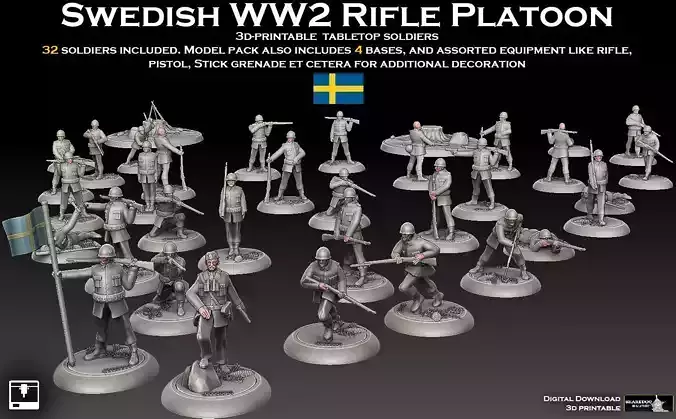1/39
Intended for 3d print.
Swedish rifle platoon from the the interbellum/early WW2 era. The soldiers are using the following equipment:
The M/39 uniform.
The M/37 steel helmet.
The Mauser M/36 (also known as the Swedish Mauser ). Based on the German Model 1893, originally designed by Paul Mauser.
The M/39 stick grenade. Known as the M24 Stiehlhandgranate in Germany. Imported and reclassified at the outset of the war, when the Swedish-made M/40 grenade proved unreliable.
The M/96 Bayonet (doubling as a knife). To my knowledge a Swedish design, and mainly manufactured in Sweden and Germany.
The M/07 Pistol. Also known FN Model 03, originally designed by John Moses Browning. Manufactured in Sweden under licence from Belgian Fabrique Nationale.
Overall, the early-war Swedish army arsenal was a hodge-podge of obsolete or hastily procured stopgap equipment, especially when it came to automatic weapons. A lot of the troops would have to make do with both weapons and clothing that were older than the equipment used for these models (like the M/21 helmet, or even the M/23 uniform). Despite never entering the war, the army would rapidly rearm and expand over the course of WW2, and ended it with substantially upgraded kit for the troops.
Rifle platoons were part of rifle companies (three to a company). The Rifle Company would also include a heavy platoon consisting of machine gun and mortar troops. The rifle platoon would also include a light 47mm mortar troop, and some machine guns and submachine guns. These are not included in this release, but will be sold as separate products. The rifle platoon would eventually be reformed in 1943 and provided with more firepower. The late-war rifle platoon will be released as a separate product at a a later date (by the time you are reading this, it may well have been released).
I haven't done the exact math, but a rifle platoon consisted of around 50 men. So you may have to print one or two of the included models twice for historical accuracy.
Printing instructions
Recommended printing scale is 28mm. The default scale of the models is also approximately 28mm when you first load them into your slicer. Note that you can easily alter the size of the models prior to printing. No models are currently pre-supported. Personally I think this gives the customer greater flexibility (as well as saving me quite a bit of effort...) , but you are welcome to send me a request to pre-support all models, and I'll upload them to the product free of charge. If you have any additional questions, for example re: various historical aspects, you can also contact me. I'm no expert, but I do have access to some fairly credible historical sources I've used when designing the models.
REVIEWS & COMMENTS
accuracy, and usability.







































